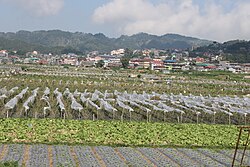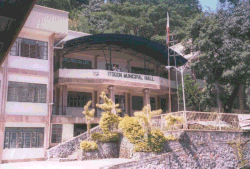Metro BLISTT Metro Baguio | |
|---|---|
| Metropolitan Baguio - La Trinidad - Itogon - Sablan - Tuba and Tublay | |
 Skyline of Baguio City at night | |
 Baguio and neighboring towns which is regarded as part of Metro Baguio. | |
| Country | Philippines |
| Region | Cordillera Administrative Region (CAR) |
| Province | Benguet |
| Managing entity | Metropolitan Baguio City, La Trinidad, Itogon, Sablan, Tuba and Tublay Development Authority (MBLISTTDA) |
| Established | April 11, 2004 |
| Metropolitan Center | Baguio |
| City/Municipality | |
| Government | |
| • Type | Council |
| • Chairman | Benjamin Magalong (mayor of Baguio ) |
| • Co-Chairman | Arthur Baldo (mayor of Sablan ) |
| • Treasurer | Edna Tabanda (mayor of La Trinidad ) |
| • Secretary | Ruben Paoad (mayor of Tublay ) |
| Area | |
• Total | 1,094.79 km2 (422.70 sq mi) |
| Elevation | 500 to 1,850 m (1,640 to 6,070 ft) |
| Population (2024) | |
• Total | 653,677 |
| • Density | 597.080/km2 (1,546.43/sq mi) |
| Time zone | UTC+8 (PST) |
| Area Code | +63 74 |
| Website | Official Facebook page |
Metro BLISTT , also known as Metro Baguio, is an agglomeration of the city of Baguio and five municipalities of the Philippine province of Benguet, namely: La Trinidad, Itogon, Sablan, Tuba, and Tublay. It is an official metropolitan area in the Philippines through Republic Act (RA) No. 11932 which lapsed into law on July 30, 2022 creating the Metropolitan Baguio City, La Trinidad, Itogon, Sablan, Tuba and Tublay Development Authority (MBLISTTDA) as a government entity with corporate powers. [2]
Contents
- Component local government units
- History
- Geography and climate
- Geography
- Climate
- Government
- Media
- Transportation
- On land
- By air
- References
Long proposed and supported by the NEDA-Regional Development Council-Cordillera, [3] it was previously defined between 2007 and 2017 as one of twelve metropolitan areas in the Philippines. [4] [5] The original "BLIST" long existed as a concept since its inception in August 1990, a month after the 1990 earthquake which devastated the city of Baguio and other surrounding areas, [6] and only existed as an informal reference to the area. The concept was later amended into "BLISTT" in 2009, which included the municipality of Tublay, despite not being adjacent to the city of Baguio. [6] It was officially established after a signing of a memorandum of agreement by the mayors of the component local government units. [7]













